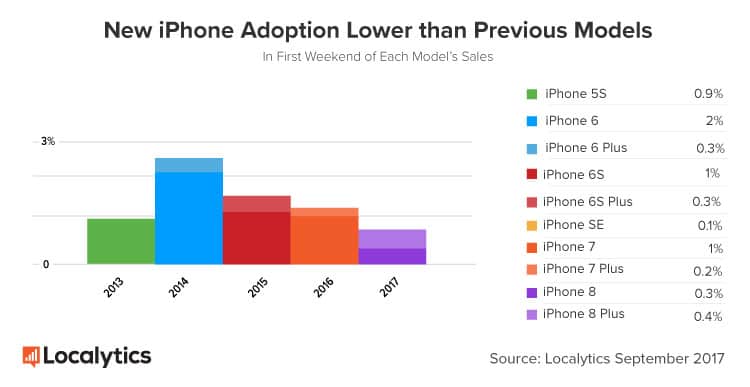 2047
2047
 2017-09-26
2017-09-26

The iPhone 8 and iPhone 8 Plus have seen lower adoption rates than any September launch of an iPhone since at least 2013, a new report by “lifestyle engagement platform” Localytics claims.
During its first weekend on sale, the iPhone 8 reportedly seized 0.3 percent of the total iPhone device market share, while the iPhone 8 Plus managed 0.4 percent. By contrast, last year’s iPhone 7 generation of handsets racked up 1.2 percent of the market in its opening weekend.
Apples and oranges
The comparison isn’t a totally fair one, of course. For one thing, the total iPhone market grows each year, which means that Apple has to sell more devices just to equal the same percentage. More importantly, the iPhone 8 and 8 Plus is considered a secondary iPhone line, compared to the far more eagerly anticipated iPhone X.

A more accurate comparison would therefore be with the iPhone SE, which was Apple’s last phone to be a non-flagship handset. Although the iPhone SE came out at a different time of year, rather than the now traditional September launch, it received just 0.1 percent of the market when it was released.
In addition, there’s the promising sign that the iPhone 8 Plus, despite no longer being the top of the line Apple flagship phone, seems to have outsold last year’s iPhone 7 Plus upon its release — with 0.4 percent of the market rather than 0.2. Interestingly, this would make it the first year where the 5.5-inch iPhone outsold the smaller 4.7-inch model.
This all bodes well for the new iPhone X. Whether it can replicate the 2 percent of the market that the 4.7-inch iPhone 6 picked up in 2014 remains to be seen, however.
iOS 11
Hand in hand with lower sales for the iPhone 8 and iPhone 8 Plus are the reports that iOS 11 has not yet matched the first six days of adoption for last year’s iOS 10. iOS 11 is reportedly installed on approximately 22 percent of eligible devices, compared to 26 percent of eligible devices this time last year for iOS 10.
Source: cult of mac